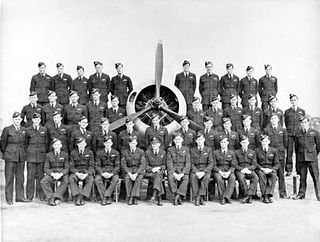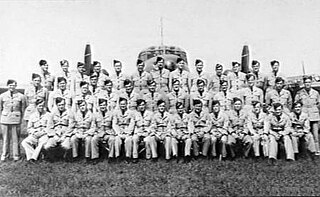Canadian Forces Base Summerside was an air force base located in St. Eleanors, Prince Edward Island, Canada, now part of the city of Summerside.

Canadian Forces Base Greenwood, or CFB Greenwood, is a Canadian Forces Base located 1.5 nautical miles east of Greenwood, Nova Scotia. It is primarily operated as an air force base by the Royal Canadian Air Force and is one of two bases in the country using the CP-140 Aurora and CP-140A Arcturus anti-submarine/maritime patrol and surveillance aircraft. Its primary RCAF lodger unit is 14 Wing, commonly referred to as 14 Wing Greenwood.

RCAF Station Aylmer was a Royal Canadian Air Force airfield that was built between late 1940 and June 1941 northeast of Aylmer, Ontario. It was one of many built across Canada under the British Commonwealth Air Training Plan during World War II.

RCAF Station Vulcan, also referred to as RCAF Aerodrome Vulcan, was a Second World War flying training station located southwest of the town of Vulcan, Alberta, Canada. It was one of many stations that were established in Canada under the British Commonwealth Air Training Plan.

RCAF Station Claresholm was a British Commonwealth Air Training Plan station that trained pilots for World War II service. The station was located near Claresholm, Alberta, Canada.

Centralia/James T. Field Memorial Aerodrome, originally RCAF Station Centralia, is located 1.6 nautical miles west of Centralia, Ontario, Canada.
RCAF Station Saskatoon was a World War II British Commonwealth Air Training Plan (BCATP) base operated by the Royal Canadian Air Force (RCAF). It was located North of the City of Saskatoon, Saskatchewan, Canada.
RCAF Station Fort Macleod was a World War II British Commonwealth Air Training Plan (BCATP) flying training station. Administrative and operational control was the responsibility of the Royal Canadian Air Force (RCAF). The old station is located south of Fort Macleod, Alberta, Canada.

Canadian Forces Base Moose Jaw, also known as 15 Wing Moose Jaw, is a Canadian Forces base located 4 nautical miles south of Moose Jaw, Saskatchewan. It is operated as an air force base by the Royal Canadian Air Force (RCAF) and is home to RCAF Pilot training and 431 Squadron, the Snowbirds, which is the RCAF's air demonstration squadron.

Several air force stations and other establishments, many of them training facilities, operated in Calgary, Alberta, Canada from the mid-1930s to the mid-1960s.

Canadian Forces Base St. Hubert was a Canadian Forces Base in the city of Saint-Hubert, Quebec. The base began as a civilian airfield in the 1920s and was later also used by RCAF auxiliary (reserve) squadrons, beginning in the mid-1930s. It became a fully-fledged RCAF station early in World War II, being extensively used for training as part of the British Commonwealth Air Training Plan. After the war, it grew into one of the most important air bases in Canada, and remained so for decades.
RCAF Station Gimli was an air station of the Royal Canadian Air Force (RCAF) located near Gimli, Manitoba, Canada.
The NATO Air Training Plan was an aircrew training program which ran from 1950–1958, authorized by NATO, and implemented by the Royal Canadian Air Force (RCAF). The program trained pilots and navigators from NATO signatory countries with the purpose of improving NATO airpower in response to the perceived military threat in Europe from Soviet bloc countries.

No. 5 Service Flying Training School was a Royal Australian Air Force (RAAF) flight training unit that operated during World War II. It was one of eight Service Flying Training Schools established by the RAAF to provide intermediate and advanced flying instruction to new pilots as part of Australia's contribution to the Empire Air Training Scheme. No. 5 SFTS was formed at RAAF Station Uranquinty, New South Wales, in October 1941, and disbanded in February 1946. Its staff and equipment were employed to re-establish No. 1 Flying Training School, which transferred to RAAF Station Point Cook, Victoria, the following year. Care and Maintenance Unit Uranquinty was also formed from No. 5 SFTS's facilities, to look after surplus aircraft at the base prior to their disposal, and disbanded in December 1948.
While the lineage of 1 Canadian Forces Flying Training School can be traced back through previous similarly named Canadian military pilot flying schools, such as No. 1 Service Flying Training School and 1 Flying Training School, the unit located at CFB Winnipeg and currently bearing the name does not participate in pilot training.

No. 3 Service Flying Training School was a flying training school of the Royal Australian Air Force (RAAF) during World War II. It was formed in September 1940, and commenced flying two months later. Responsible for intermediate and advanced instruction of pilots under the Empire Air Training Scheme (EATS), the school was based at RAAF Station Amberley, Queensland, and operated CAC Wirraway and Avro Anson aircraft. Two reserve squadrons were formed at the school in response to the outbreak of war in the Pacific, and the base fortified against air attack. In March 1942 the RAAF divided the staff and equipment of No. 3 SFTS between Nos. 1 and 6 Service Flying Training Schools at Point Cook, Victoria, and Mallala, South Australia, respectively. No. 3 SFTS was disbanded the following month.

Royal Canadian Air Force Station Dunnville was a Second World War British Commonwealth Air Training Plan (BCATP) station located near Dunnville, Ontario. The station was home to No. 6 Service Flying Training School and is usually known by that name. Service Flying Training schools trained pilots, either single engine or multi-engine, and 6 SFTS was a single engine school. After graduation the new pilots were assigned various duties, which might be overseas in the Royal Air Force or an RCAF squadron; or in Canada as instructors or staff pilots in the BCATP, or for duty in RCAF Home Defence squadrons.
RCAF Station Estevan was a World War II, British Commonwealth Air Training Plan (BCATP) base operated by the Royal Canadian Air Force (RCAF). It was located South of the City of Estevan, Saskatchewan, Canada.















